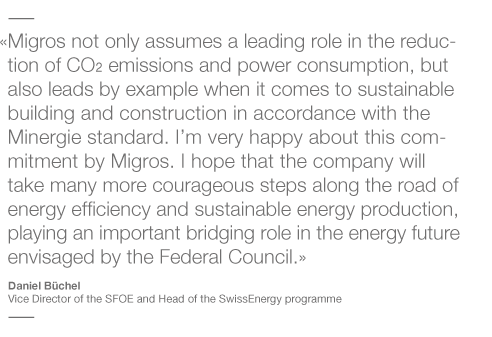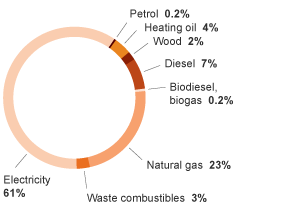
Protecting the climate by using less energy
Migros' commitment to saving energy and its responsibility for climate protection are key pillars of the company's sustainability strategy. The new 2020 climate and energy strategy came into force in 2012.
For almost four decades, Migros has been working on systematically reducing its power and energy consumption. All stores, logistics centres, Migros industrial enterprises and Fitnessparks are now integrated in the company's comprehensive environmental and energy management. Furthermore, the retailers Globus, Interio, Denner and Migrol, along with Migros Bank and the tour operator Hotelplan, also record important key indicators such as energy consumption and CO2 emissions.
Climate strategy extended
In 2011 Migros revised its first climate and energy strategy from 2007. The new targets for Cooperative Retailing are: reduce greenhouse gases by 20% and power consumption by 10% before 2020 (in relation to 2010). Last year, Migros also defined a climate and energy strategy for its industrial enterprises, the objectives of which were further substantiated by the individual enterprises. It also analysed climate risks in detail for the first time. The key risks in the company's direct areas of activity include physical risks such as the scarcity of agricultural produce, regulatory risks such as climate levies, and market price risks such as higher energy costs. As a whole, the analysis showed that Migros is well or very well prepared for the foreseeable changes.
Charts on CO2 target agreements
Cooperative Retailing and Industry
Greenhouse gas emissions reduced
To reduce its greenhouse gas emissions, Migros has been collaborating with the Energy Agency for the Economy (EnAW) since 2002. Individual energy and climate targets apply for all Migros branches as well as logistics and industrial enterprises, for the head offices of Hotelplan, Migros Bank, Migros Federation of Cooperatives, for the major department stores of Globus and Interio, and for 17 Fitnessparks. Summary: between 2000 and 2012, Migros managed to reduce CO2 in the area of combustibles and propellants by 29.5%.
Since last year, Migros considers all greenhouse gas emissions in its objectives. This includes refrigerant losses, which now represent the biggest direct climate burden in the branch area, as well as the indirect greenhouse gases caused by power consumption. The company systematically attempts to reduce refrigerant losses. All industrial enterprises, as well as Cooperative Retailing, are now CFC free. The branches use carbon dioxide as the standard refrigerant in the new cooling systems. Its carbon footprint is 1000 times lower than synthetic refrigerants like FC or HFC, the conventional alternatives for HCFC.
Migros already operates some 300 carbon dioxide cooling systems in the branches. This means around 13% of the cooling systems have been converted to CO2 refrigerants and 35% of the branches use CO2 as a refrigerant. Last year, Migros received recognition for this achievement from the Environmental Investigation Agency. At present, Migros as a whole still operates 439 HCFC systems, but aims to replace these by the end of 2014. The refilling of HCFC refrigerants will be banned as of January 2015.

Charts on greenhouse gas emissions
Cooperative Retailing and Industry
1 Income from Migros Cooperative Retailing and Industry (Migros Cooperatives, FMC, industrial and logistics companies)
3 Scope of greenhouse gas emissions according to Greenhouse Gas Protocol
4 Own vehicle fleets of the Migros Cooperatives and Scana
5 In accordance with Swiss consumption mix at 154g CO2eq/kWh power
Table «Direct und indirect greenhouse gas emissions (GHG) 2012» (Migros Group).
Charts on refrigerating systems
2 Operating centres, distribution units and FMC
More energy efficiency
Migros' absolute total energy consumption has hardly changed in the last few years. However, the energy consumption per square meter of sales area has fallen continuously due to the many different efficiency measures. Among the industrial enterprises, energy consumption has also remained constant, even though the processes are becoming more elaborate. In comparison to the previous year, Migros' total energy consumption in 2012 fell by 0.5%.
Charts on energy consumption
Cooperative Retailing and Industry
Proportion of energy carriers in total energy consumption
Total consumption: 1'589 GWh

1 Income from Migros Cooperative Retailing and Industry (Migros Cooperatives, FMC, industrial and logistics companies)
4 Own vehicle fleets of the Migros Cooperatives and Scana
Table on energy consumption
Migros Group
Total energy consumption, absolute 2012
[in GWh]
| Electricity | Heat | Fuel5 | TOTAL | |
| Cooperative Retailing | 647 | 133 | 106 | 886 |
| Stores | 503 | 73 | 576 | |
| Logistics companies2 | 144 | 60 | 106 | 310 |
| Industry | 316 | 380 | 6 | 703 |
| Cooperative Retailing + Industry | 963 | 513 | 112 | 1'588 |
| Commerce3 | 123 | 28 | 151 | |
| Financial Services and Travel4 | 10 | 1 | 11 | |
| Leisure Facilities (Fitnessparks) | 23 | 24 | 47 | |
| TOTAL | 1'119 | 567 | 112 | 1'797 |
2 Operating centres, distribution units and FMC
3 Based on data of retailers Globus, Interio, Migrol and Denner (contains some projections)
4 Based on data of Migros Bank and Hotelplan Switzerland
5 Own vehicle fleets of the Migros Cooperatives and Scana
Sustainable construction
With a total area of 821'526 square metres, Migros is still the Swiss champion in implementing the Minergie standard. In addition to 32 Migros supermarkets, 50 other buildings such as offices, residential buildings of the Migros Pension Fund and migrolino petrol station shops have since been awarded the label.
Minergie supermarkets are characterised by highly insulated building shells, controlled ventilation systems, power-saving lighting and efficient cooling systems. In 2012 Migros decided to increase its existing commitment to sustainable construction and to build all branches in an environmentally friendly way as standard. In addition to high energy efficiency, this also includes aspects such as material ecology in the buildings as well as biodiversity in the design of surroundings. Eight Migros enterprises have already been awarded certificates for exemplary company premises by the Nature & Business Foundation. More are currently being assessed and are expected to follow.
Chart on Minergie-certified area
Migros Group
9 Increase in the Minergie-certified area from 2010 to 2011 due in part to a more comprehensive survey and reconciliation with the Minergie association
Power-saving branches
About half of all power in supermarkets is consumed by freezer and cooling units. With state-of-the-art refrigeration, this power consumption can in some cases be reduced dramatically. A cooling unit with glass doors uses up to 45% less power than an equivalent one without glass doors. This was demonstrated in a broad pilot experiment at Migros in 2011. An increasing number of regional cooperatives are focusing on this measure, and 78 branches have now been fitted with glass doors (fully or in individual areas).
Migros is also a pioneer when it comes to lighting: as far back as 2006, Migros opened the world's first supermarket to be fitted entirely with LED lights in the sales area. Since then, it has been equipping more and more branches with them. Last year, this included sales areas in Brunnen and Weinfelden, which now need only half the usual amount of power for lighting.
Renewable energy
Migros is one of the biggest buyers of renewable power in Switzerland and procured 87 GWh of certified green power (naturemade star and basic as well as TÜV-certified green power) in 2012. Migros is also committed to climate-friendly energy supply and operates its own solar power plants and small wind turbines or provides its roofs for such installations. In 2012 a wind turbine and four new solar power plants on Migros roofs were put into operation – including the largest photovoltaic system in the canton of Ticino. As such, a total of 24 photovoltaic systems are in use on Migros buildings. They generate some 4400 MWh of power annually, which corresponds to the power consumption of around 1050 family homes. In addition to the sun, Migros relies on other climate-neutral energy sources: seven Migros logistics centres already use heat from renewable energies like wood, geothermal heat or district heating. The share of renewable energies in the total heat consumption is 79'400 MWh (around 15%).
Chart on proportion of heat from renewable energies
Cooperative Retailing and Industry